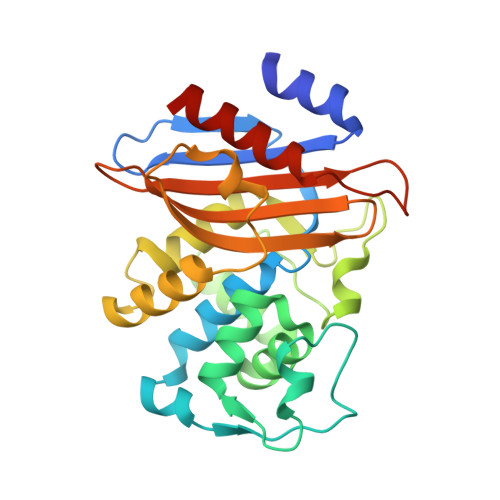Structural Basis of the Inhibition of Class a Beta-Lactamases and Penicillin-Binding Proteins by 6-Beta-Iodopenicillanate.
Sauvage, E., Zervosen, A., Dive, G., Herman, R., Amoroso, A., Joris, B., Fonze, E., Pratt, R.F., Luxen, A., Charlier, P., Kerff, F.(2009) J Am Chem Soc 131: 15262
- PubMed: 19919161
- DOI: https://doi.org/10.1021/ja9051526
- Primary Citation of Related Structures:
2WK0, 2WKE - PubMed Abstract:
6-Beta-halogenopenicillanates are powerful, irreversible inhibitors of various beta-lactamases and penicillin-binding proteins. Upon acylation of these enzymes, the inhibitors are thought to undergo a structural rearrangement associated with the departure of the iodide and formation of a dihydrothiazine ring, but, to date, no structural evidence has proven this. 6-Beta-iodopenicillanic acid (BIP) is shown here to be an active antibiotic against various bacterial strains and an effective inhibitor of the class A beta-lactamase of Bacillus subtilis BS3 (BS3) and the D,D-peptidase of Actinomadura R39 (R39). Crystals of BS3 and of R39 were soaked with a solution of BIP and their structures solved at 1.65 and 2.2 A, respectively. The beta-lactam and the thiazolidine rings of BIP are indeed found to be fused into a dihydrothiazine ring that can adopt two stable conformations at these active sites. The rearranged BIP is observed in one conformation in the BS3 active site and in two monomers of the asymmetric unit of R39, and is observed in the other conformation in the other two monomers of the asymmetric unit of R39. The BS3 structure reveals a new mode of carboxylate interaction with a class A beta-lactamase active site that should be of interest in future inhibitor design.
Organizational Affiliation:
Centre d'Ingénierie des Protéines and Centre de Recherches du Cyclotron, Université de Liège, B-4000 Sart Tilman, Belgium. [email protected]



















